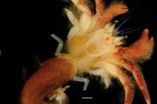(Press-News.org) The wild and dramatic cascade of ice into the ocean from Alaska's Columbia Glacier, an iconic glacier featured in the documentary "Chasing Ice" and one of the fastest moving glaciers in the world, will cease around 2020, according to a study by the University of Colorado Boulder.
A computer model predicts the retreat of the Columbia Glacier will stop when the glacier reaches a new stable position -- roughly 15 miles upstream from the stable position it occupied prior to the 1980s. The team, headed by lead author William Colgan of the CU-Boulder headquartered Cooperative Institute for Research in Environmental Sciences, published its results today in The Cryosphere, an open access publication of the European Geophysical Union.
The Columbia Glacier is a large (425 square miles), multi-branched glacier in south-central Alaska that flows mostly south out of the Chugach Mountains to its tidewater terminus in Prince William Sound.
Warming air temperatures have triggered an increase in the Columbia Glacier's rate of iceberg calving, whereby large pieces of ice detach from the glacier and float into the ocean, according to Colgan. "Presently, the Columbia Glacier is calving about 2 cubic miles of icebergs into the ocean each year -- that is over five times more freshwater than the entire state of Alaska uses annually," he said. "It is astounding to watch."
The imminent finish of the retreat, or recession of the front of the glacier, has surprised scientists and highlights the difficulties of trying to estimate future rates of sea level rise, Colgan said. "Many people are comfortable thinking of the glacier contribution to sea level rise as this nice predictable curve into the future, where every year there is a little more sea level rise, and we can model it out for 100 or 200 years," Colgan said.
The team's findings demonstrate otherwise, however. A single glacier's contribution to sea level rise can "turn on" and "turn off" quite rapidly, over a couple of years, with the precise timing of the life cycle being difficult to forecast, he said. Presently, the majority of sea level rise comes from the global population of glaciers. Many of these glaciers are just starting to retreat, and some will soon cease to retreat.
"The variable nature and speed of the life cycle among glaciers highlights difficulties in trying to accurately predict the amount of sea level rise that will occur in the decades to come," Colgan said.
The Columbia Glacier was first documented in 1794 when it appeared to be stable with a length of 41 miles. During the 1980s it began a rapid retreat and by 1995 it was only about 36 miles long. By late 2000 it was about 34 miles long.
The loss of a massive area of the Columbia Glacier's tongue has generated a tremendous number of icebergs since the 1980s. After the Exxon Valdez ran aground while avoiding a Columbia Glacier iceberg in 1989, significant resources were invested to understand its iceberg production. As a result, Columbia Glacier became one of the most well-documented tidewater glaciers in the world, providing a bank of observational data for scientists trying to understand how a tidewater glacier reacts to a warming climate.
Motivated by the compelling imagery of the Columbia Glacier's retreat documented in the Extreme Ice Survey -- James Balog's collection of time-lapse photography of disappearing glaciers around the world -- Colgan became curious as to how long the glacier would continue to retreat. To answer this question, the team of researchers created a flexible model of the Columbia Glacier to reproduce different criteria such as ice thickness and terminus extent.
The scientists then compared thousands of outputs from the computer model under different assumptions with the wealth of data that exists for the Columbia Glacier.
The batch of outputs that most accurately reproduced the well-documented history of retreat was run into the future to predict the changes the Columbia Glacier will most likely experience until the year 2100. The researchers found that around 2020 the terminus of the glacier will retreat into water that is sufficiently shallow to provide a stable position through 2100 by slowing the rate of iceberg production.
The speediness of the glacier's retreat is due to the unique nature of tidewater glaciers, Colgan said. When warming temperatures melt the surface of a land glacier, the land glacier only loses its mass by run-off. But in tidewater glaciers, the changes in ice thickness resulting from surface melt can create striking changes in ice flow, triggering an additional dynamic process for retreat.
The dynamic response of the Columbia Glacier to the surface melt will continue until the glacier reaches its new stable position in 2020, at roughly 26 miles long. "Once the dynamic trigger had been pulled, it probably wouldn't have mattered too much what happened to the surface melt -- it was just going to continue retreating through the bedrock depression upstream of the pre-1980s terminus," Colgan said.
Colgan next plans to attempt to use similar models to predict when the Greenland glaciers -- currently the major contributors to sea level rise -- will "turn off" and complete their retreats.
The future for the Columbia Glacier, however, looks bleak. "I think the hope was that once we saw climate change happening, we could act to prevent some irreversible consequences," Colgan said, "but now we are only about eight years out from this retreat finishing -- it is really sad. There is virtually no chance of the Columbia Glacier recovering its pre-retreat dimensions on human time-scales."
###
The study was funded by NASA, and co-authors on the paper include W. Tad Pfeffer of CU-Boulder's Institute of Arctic and Alpine Research, Harihar Rajaram of the CU-Boulder Department of Civil, Environmental, and Architectural Engineering, Waleed Abdalati of the National Aeronautic and Space Administration in Washington, D.C., and Balog of the Extreme Ice Survey in Boulder, Colo.
The complete study is available online at http://www.the-cryosphere.net/6/1395/2012/.
Contact:
William Colgan, CIRES, 011-45-5290-1585
William.Colgan@colorado.edu
Jane Palmer, CIRES science writer, 303-883-4398
Jane.Palmer@colorado.edu
END
SEATTLE—After gastric bypass surgery, diabetes goes away for some people—often even before they lose much weight. So does that mean gastric surgery "cures" diabetes? Not necessarily, according to the largest community-based study of long-term diabetes outcomes after bariatric surgery. For most people in the study, e-published in advance of print in Obesity Surgery, diabetes either never remitted after gastric surgery or relapsed within five years.
Among the two thirds of the study's patients whose diabetes at first went away, more than a third re-developed diabetes again ...
They say that the eyes are the windows to the soul. However, to get a real idea of what a person is up to, according to UC Santa Barbara researchers Miguel Eckstein and Matt Peterson, the best place to check is right below the eyes. Their findings are published in the Proceedings of the National Academy of Sciences.
"It's pretty fast, it's effortless –– we're not really aware of what we're doing," said Miguel Eckstein, professor of psychology in the Department of Psychological & Brain Sciences. Using an eye tracker and more than 100 photos of faces and participants, Eckstein ...
PHILADELPHIA — Electronic circuits are typically integrated in rigid silicon wafers, but flexibility opens up a wide range of applications. In a world where electronics are becoming more pervasive, flexibility is a highly desirable trait, but finding materials with the right mix of performance and manufacturing cost remains a challenge.
Now a team of researchers from the University of Pennsylvania has shown that nanoscale particles, or nanocrystals, of the semiconductor cadmium selenide can be "printed" or "coated" on flexible plastics to form high-performance electronics.
The ...
You may have received CPR training some time ago, but would you remember the proper technique in an emergency? Would you know what to do in the event of an earthquake or a fire? A new UCLA psychology study shows that people often do not recall things they have seen — or at least walked by — hundreds of times.
For the study, 54 people who work in the same building were asked if they knew the location of the fire extinguisher nearest their office. While many of the participants had worked in their offices for years and had passed the bright red extinguishers several times ...
Johns Hopkins researchers report concrete steps in the use of human stem cells to test how diseased cells respond to drugs. Their success highlights a pathway toward faster, cheaper drug development for some genetic illnesses, as well as the ability to pre-test a therapy's safety and effectiveness on cultured clones of a patient's own cells.
The project, described in an article published November 25 on the website of the journal Nature Biotechnology, began several years ago, when Gabsang Lee, D.V.M., Ph.D., an assistant professor at the Johns Hopkins University School ...
ITHACA, N.Y. – Are juicier, sweeter, more disease-resistant watermelons on the way? An international consortium of more than 60 scientists from the United States, China, and Europe has published the genome sequence of watermelon (Citrullus lanatus) — information that could dramatically accelerate watermelon breeding toward production of a more nutritious, tastier and more resistant fruit. The watermelon genome sequence was published in the Nov. 25 online version of the journal Nature Genetics.
The researchers discovered that a large portion of disease resistance genes ...
DURHAM, N.C. -- One tropical lizard's tolerance to cold is stiffer than scientists had suspected.
A new study shows that the Puerto Rican lizard Anolis cristatellus has adapted to the cooler winters of Miami. The results also suggest that this lizard may be able to tolerate temperature variations caused by climate change.
"We are not saying that climate change is not a problem for lizards. It is a major problem. However, these findings indicate that the thermal physiology of tropical lizards is more easily altered than previously proposed," said Duke biologist Manuel ...
HOUSTON - Researchers at The University of Texas MD Anderson Cancer Center have tracked down a cancer-promoting protein's pathway into the cell nucleus and discovered how, once there, it fires up a glucose metabolism pathway on which brain tumors thrive.
They also found a vital spot along the protein's journey that can be attacked with a type of drug not yet deployed against glioblastoma multiforme, the most common and lethal form of brain cancer. Published online by Nature Cell Biology, the paper further illuminates the importance of pyruvate kinase M2 (PKM2) in cancer ...
Areopaguristes tudgei. That's the name of a new species of hermit crab recently discovered on the barrier reef off the coast of Belize by Christopher Tudge, a biology professor at American University in Washington, D.C.
Tudge has been interested in biology his whole life, from boyhood trips to the beach collecting crustaceans in his native Australia, to his undergraduate and PhD work in zoology and biology at the University of Queensland. He has collected specimens all over the world, from Australia to Europe to North and South America.
Until now, he has never had ...
Athens, Ga. – More people are better off thanks to the impact of an influx of direct-to-consumer advertising spending than they would be without those marketing efforts, according to a study recently published by Jayani Jayawardhana, an assistant professor in the University of Georgia College of Public Health.
The multi-year study focused on advertising efforts surrounding cholesterol-reducing prescription medications. Jayawardhana found increased levels of consumer welfare due to direct-to-consumer advertising than when compared to situations without this type of marketing. ...





